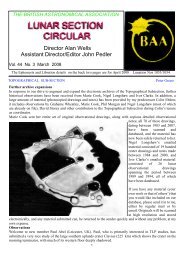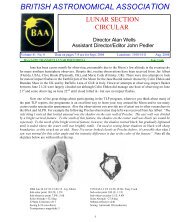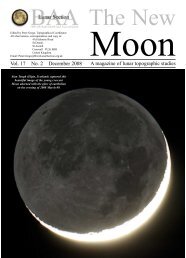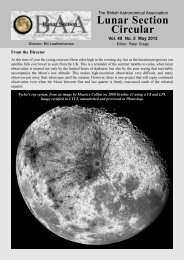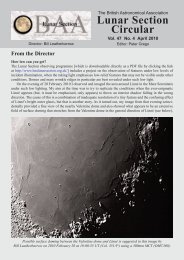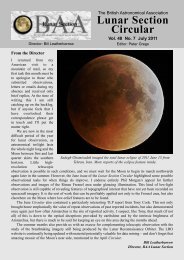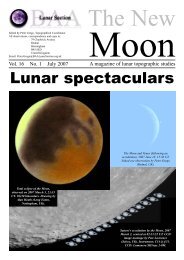Vol 50, No 5, May 2013 - BAA Lunar Section
Vol 50, No 5, May 2013 - BAA Lunar Section
Vol 50, No 5, May 2013 - BAA Lunar Section
- No tags were found...
Create successful ePaper yourself
Turn your PDF publications into a flip-book with our unique Google optimized e-Paper software.
Director: Bill LeatherbarrowThe British Astronomical Association<strong>Lunar</strong> <strong>Section</strong>Circular<strong>Vol</strong>. <strong>50</strong> <strong>No</strong>. 5 <strong>May</strong> <strong>2013</strong>Editor: Peter GregoAlan Tough secured this image of the partial lunareclipse of <strong>2013</strong> April 25 at 20:05 UT fromLossiemouth, Moray, Scotland, with a tripod-mountedCanon EOS 60D and Sigma EX 1<strong>50</strong>-<strong>50</strong>0 mm lens.
From the DirectorThe April issue of the LSC contained much material of interest to those fascinated by lunar topographic oddities.In particular I was struck by Damian Peach’s fine image of the Hevelius region, taken on 2012 December 26, andby the selection of material submitted by Richard Baum relating to the feature known informally as ‘Larrieu’sDam’. Nigel Longshaw has written about the latter in a fine paper in the <strong>BAA</strong> Journal (<strong>Vol</strong>. 118, <strong>No</strong>. 2, 2008 April),and Damian’s image includes a feature that has also caught Nigel’s attention in the past – the so-called ‘MiyamoriValley’ (see the <strong>BAA</strong> Journal, <strong>Vol</strong>. 118, <strong>No</strong>. 6, 2008 December). Both ‘Larrieu’s Dam’ and the ‘Miyamori Valley’are minor features, it must be admitted, but they have intrigued observers and challenged ready interpretation in thepast. It seemed reasonable to me to check whether the new tools available to us via the LROC Quickmap (inparticular the possibility of plotting elevation profiles) could offer new insights.Is there a ‘Miyamori Valley’?Nigel’s paper traced the observationalhistory of this linear feature runningwest from Lohrmann towardsRiccioli (Fig. 1, a crop from Damian’simage). At the telescope and underearly morning illumination it looksfor all the world like a lesser versionof the Alpine Valley, but it is almostundetectable as such on imagery fromspacecraft (Fig. 2). Nigel concludedthat it was not a valley at all, butsimply an illusion created from thechance alignment of surface features,in particular a cliff-like ridge markingthe southern edge of the ‘valley’. Heis probably right, but the LROCelevation plots suggest that the featureis valley-like along at least part of itslength. A plot taken from north tosouth at a point immediately to the2The ‘Miyamori Valley’, imaged on 2012 December 26 at 19:15 UT byDamian Peach (Fig. 1, above), and (Fig. 2, below) imaged by <strong>Lunar</strong>Orbiter IV in 1967 (detail from image IV-169-H1).<strong>BAA</strong> <strong>Lunar</strong> <strong>Section</strong> Circular <strong>Vol</strong>. <strong>50</strong> <strong>No</strong>. 5 <strong>May</strong> <strong>2013</strong>
west of Riccioli G (Fig. 3) shows theprominent ridge mentioned above,marking the southern edge. However,there is no sign of a correspondingnorthern edge to the ‘valley’.However, a plot taken at the midpointof the Miyamori feature,southwards from the crater LohrmannN, does suggest the profile of a valley(Fig. 4). It is not completelyconvincing, but it does leave open thepossibility that the ‘Miyamori Valley’is indeed a graben-like feature,perhaps heavily modified by ejectafrom the Orientale basin.Fig. 3 (top right). N-S elevationplot west of Riccioli G.Fig. 4 (right). Elevation plot southfrom Lohrmann N.Fig. 3.Fig. 4.‘Larrieu’s Dam’There is no such ambiguity over‘Larrieu’s Dam’, properly known asPolybius K – it is certainly not a dam!However, it is an oddity – a peculiar polygonal crater with astraight, sharply defined, dam-like wall abutting what appearsto be an older, much-degraded enclosure to the north-west(Fig. 5). The appearance of a dam is indeed very striking whenthe lighting conditions are just right and Polybius K is filledwith shadow. It looks very much like the sort of straightboundary between contiguous craters that is produced by thesimultaneous impact of two bodies. However, it isimmediately obvious that Polybius K is much younger than thedegraded enclosure on the other side of the ‘dam’, so there canbe no question of simultaneous impact. It is also much deeper,as the elevation profile in Fig. 6 (measured from Polybius J toPolybius K) clearly shows. Nigel Longshaw has argued thatthere is evidence for a small-scale ‘grid’ pattern in this area,possibly attributable to fault lines, and that the deformation ofPolybius K might be the result of that. Certainly there are otherexamples of straight ridges nearby, such as that separating theadjacent craters Polybius F andPolybius C, but it is arguable whetherthese constitute a grid system and thequestion remains open.Fig. 5. Polybius region from <strong>Lunar</strong> Orbiter IV,Frame 084.Fig. 6. NW-SE plot from Polybius J to Polybius K.One thing is certain: both the‘Miyamori Valley’ and ‘Larrieu’sDam’ are worthy of furtherinvestigation, not only at thetelescope but also using the othertools we now have at our disposal.Bill LeatherbarrowDirector, <strong>BAA</strong> <strong>Lunar</strong> <strong>Section</strong><strong>BAA</strong> <strong>Lunar</strong> <strong>Section</strong> Circular <strong>Vol</strong>. <strong>50</strong> <strong>No</strong>. 5 <strong>May</strong> <strong>2013</strong> 3
Topographical notescompiled by Peter GregoVisual studies and observationsSince April’s <strong>Lunar</strong> <strong>Section</strong> Circular, visual topographic lunar observational drawings have been receivedfrom Peter Grego (St Dennis, UK), Chuck Hastorf (Arizona, USA) and Dale Holt (Chipping, UK).HippalusPeter Grego<strong>2013</strong> April 2022:00-23:00 UTCol. 33.9-34.4°Libration Lat. +07.26° Long -06.45°Lunation 10.56 dSeeing: AII, good, slight mist, no wind300 mm Newtonian, 1<strong>50</strong>-200x, integrated lightLocation: St Dennis, Cornwall, UKObservational drawing on PDA<strong>No</strong>tes: This observational drawing, centred onHippalus (58 km) took in Hippalus A and D pluspart of Loewy (24 km) in the northwest,Agatharchides A to the northeast, PromontoriumKelvin in the southwest and a small part ofCampanus (its inner western wall) in thesoutheast. My previous observation of Hippalustook place on 2008 December 7, when the craterhad just begun to emerge from the morningterminator and most of its interior was in shadow.This time the Sun was several degrees higher,and much of Hippalus’ interior was illuminated.The numerous arcuate rilles of the RimaeHippalus were immediately obvious owing to thefavourable illumination.Hippalus’ interior northwestern wallappeared as a bright line, and its rim cast a broadtriangular shadow west, its apex pointing towardsHippalus A. Rima I Hippalus was clearly traceable froma shadowed junction on the north edge of Rupes Kelvin,northward across the plain south of Hippalus andthrough Hippalus itself, missing the tip of the remnantsof its northern rim and proceeding east of Hippalus Band the central ‘spine’ of hills to its north; continuing, itcut across Hippalus’ northern wall, passing west ofAgatharchides A and faded out as it approached the hillssouth of Agatharchides. The eastern floor of Hippalusappeared to contain a north-south aligned ridge.Rima II Hippalus was traceable from the foot of thenorthern edge of Rupes Kelvin, but its continuationfurther south through the mountains was not clear; itheaded north across the plain south of Hippalus andfaded as it approached the foot of Hippalus’ outersoutheastern wall. Rima II Hippalus took up again neara small hill just beyond the eastern rim of Hippalus. Itproceeded north and entered the shadow cast by thewest rim of Agatharchides A, and then passed betweenDetail from Mike Brown’s image taken at20:42 on the same evening (full image p12).4<strong>BAA</strong> <strong>Lunar</strong> <strong>Section</strong> Circular <strong>Vol</strong>. <strong>50</strong> <strong>No</strong>. 5 <strong>May</strong> <strong>2013</strong>
two mountains and on to the hills south of Agatharchides. <strong>No</strong> sign of the smaller rille between Rima I and Rima IIHippalus was seen.Yet further east, Rima III Hippalus emanated from a complex junction at the edge of Rupes Kelvin, though itwas uncertain whether the rille could actually be traced across the mountains; at any rate it was disjointed here.Following a slightly less arcuate path across the plain it entered a shadowed area south of Campanus A but it didnot appear to cut through the crater; it took up again north of it, curving around the eastern flanks a smallmountainand entered shadow cast by the western rim of Agatharchides A; it did not intrude upon the crater and onits emergence from the shadow continued across the plain beyond the edge of the area sketched. The terminatorappeared to shift during the observing session, causing more subtle features to be seen in the mare to the north ofPromontorium Kelvin; these consisted of numerous wrinkle ridges and low elevations, in themselves worth a studyof their own.ArzachelDale Holt<strong>2013</strong> April 19, 20:30 UT<strong>50</strong>5 mm Newtonian, Watec 120N+ vidcam<strong>No</strong>tes: A sketch centred on Arzachel, 96 kmdiameter and 3.6 km deep, a relatively younglunar crater in the highlands in the south-centralpart of the Moon, close to the zero meridian. Itlies to the south of Alphonsus, and together withPtolemaeus further north the three form aprominent line of craters east of Mare Nubium.The smaller Alpetragius lies to the northwest, andThebit is to the southwest along the edge of themare. Sketch made working at low power withthe Watec 120N+ video camera, Conte hardpastels on black art paper.Montes RiphaeusDale Holt<strong>2013</strong> April 20, 21:30 UT<strong>50</strong>5 mm Newtonian, Watec 120N+ vidcam<strong>No</strong>tes: Montes Riphaeus is an irregular range of lunarmountains that lies along the west-northwestern edge ofMare Cognitum, on the southeastern edge of OceanusProcellarum. The range trends generally from northnortheastto south-southwest. It includes a number ofslender ridge lines with valleys flooded by intrudingflows of lava. The range is located at selenographiccoordinates 7.7° S, 28.1° W. It has a diameter of 189 km,although it is typically only about 30-<strong>50</strong> km wide. Thenearest feature of note is Euclides, a small but prominentcrater to the west. About 100 km to the north is the craterLansberg. I took my time with this sketch using whiteacrylic paint to highlight the numerous peaks and highridges.<strong>BAA</strong> <strong>Lunar</strong> <strong>Section</strong> Circular <strong>Vol</strong>. <strong>50</strong> <strong>No</strong>. 5 <strong>May</strong> <strong>2013</strong> 5
Sunset on Fra Mauro<strong>2013</strong> March 512:28 UTColong. 188.5°Lib. lat. -02.56°Lib. lon. -00.12°Lunation: 23.2 d200 mm SCT, 164x<strong>No</strong>tes: The subject of thisdrawing is famous as thelanding site of Apollo 14 andthe target of ill-fated Apollo13—the Fra Mauro region.Frau Mauro is very worn.Neighboring Bonpland andParry are much moredistinctive. The entire regionstands out because of itsdramatic location on theborders of Mare Cognitum(SW) and Mare Nubium (NW).Seeing was average at best,limiting my usablemagnification. Final drawingmade using a Wacom Bambootablet and Sketchbook Prosoftware.Alphonsus<strong>2013</strong> <strong>May</strong> 1Lunation: 21.09dColong. 162.9°Lib. lat. -05.43°Lib. lon. +04.15°200 mm SCT, 164x.<strong>No</strong>tes: My Wacom tabletgave up the ghost. Attached isan old fashioned #2 pencilsketch of Alphonsus crater. Iwas looking for the darkenededges of the crater walls forthe evidence of volcanismbut didn’t have much luck.Still, Alphonsus is veryinteresting. The viewing wasless than optimal. There waslots of cirrus and I only gotintermittent peeks of clearseeing.Chuck HastorfChuck Hastorf6<strong>BAA</strong> <strong>Lunar</strong> <strong>Section</strong> Circular <strong>Vol</strong>. <strong>50</strong> <strong>No</strong>. 5 <strong>May</strong> <strong>2013</strong>
Above: Colin Henshaw’s image of the partial lunar eclipse of<strong>2013</strong> April 25, taken at 20:06 UT using a DSLR at 1/1000 s setto ISO 1000 coupled to an 80 mm OG (f/l <strong>50</strong>0 mm, x3TC-1).More of Alan Tough’s images of the partial eclipse, taken at20:03 UT (below) and 20:07 UT (right).<strong>BAA</strong> <strong>Lunar</strong> <strong>Section</strong> Circular <strong>Vol</strong>. <strong>50</strong> <strong>No</strong>. 5 <strong>May</strong> <strong>2013</strong> 7
<strong>Lunar</strong> imagesA gallery of 29 whole Moon lunar phase images has been set up on the <strong>BAA</strong> <strong>Lunar</strong> <strong>Section</strong> website. Manythanks to Rolf Hempel, whose images they are, for enabling us to feature such spectacular work. The gallerycan be found at: http://www.baalunarsection.org.uk/phases.htmSince April’s LSC, lunar images (or links to images) have been received from Klaus Brasch (USA), MikeBrown (York, UK), Alan Clitherow (Cupar, UK), Maurice Collins (New Zealand), David Finnigan (UK),Richard Hill (USA), Bill Leatherbarrow (Sheffield, UK). A selection of these images is featured below. Myapologies to those contributors whose hard-won work is not featured in this issue; limited space means thatonly a sample of material (with preference to <strong>BAA</strong> members) is included.Copernicus and EratosthenesKlaus BraschI have attached a modest contribution taken with my TMB-130 f/7 apo refractor and 2x Barlow on April 19,2012. I used a Canon 60Da in movie crop mode under rather good seeing. This collage consists of two setsof ~800 images each (at 60 fps) stacked and processed in Registax 6 and then merged in Photoshop. I thoughtreaders might find this interesting since this DSLR, which I use mainly for deep sky imaging, can also workquite well in the movie crop mode for lunar and planetary imaging. You might have read the article about thisby Jerry Lodriguss in the <strong>May</strong> 2012 issue of Sky & Telescope.8<strong>BAA</strong> <strong>Lunar</strong> <strong>Section</strong> Circular <strong>Vol</strong>. <strong>50</strong> <strong>No</strong>. 5 <strong>May</strong> <strong>2013</strong>
<strong>BAA</strong> <strong>Lunar</strong> <strong>Section</strong> Circular <strong>Vol</strong>. <strong>50</strong> <strong>No</strong>. 5 <strong>May</strong> <strong>2013</strong> 9
10<strong>BAA</strong> <strong>Lunar</strong> <strong>Section</strong> Circular <strong>Vol</strong>. <strong>50</strong> <strong>No</strong>. 5 <strong>May</strong> <strong>2013</strong>
<strong>BAA</strong> <strong>Lunar</strong> <strong>Section</strong> Circular <strong>Vol</strong>. <strong>50</strong> <strong>No</strong>. 5 <strong>May</strong> <strong>2013</strong> 11
12<strong>BAA</strong> <strong>Lunar</strong> <strong>Section</strong> Circular <strong>Vol</strong>. <strong>50</strong> <strong>No</strong>. 5 <strong>May</strong> <strong>2013</strong>
<strong>BAA</strong> <strong>Lunar</strong> <strong>Section</strong> Circular <strong>Vol</strong>. <strong>50</strong> <strong>No</strong>. 5 <strong>May</strong> <strong>2013</strong> 13
Rik notes: When I was a youngster in the early 1960s with my 2.4-inch refractor just starting my study of the Moon, I recall beingdisappointed as full Moon approached and, to my mind then, thingswould get boring. For a time there would be no easily observedterminator with all its topography, only bright and dark blotcheswhich at that time were much less interesting to me. But before thefull phase there was this isolated odd lump on the terminator that Icould spot. At that time my lunar library was limited to PatrickMoore’s Survey of the Moon and Flammarion’s Astronomy andneither made mention of it. I later found that it was Mons Rumker.Seen here Mons Rumker is not a featureless lump but a domelikemound with separate rounded peaks standing solitary in the flatplain of Sinus Roris. I cannot for the life of me understand howearlier lunar observers saw this as a ruined crater! <strong>No</strong>tice thesinuous dorsa to the south and complex braiding of dorsa to thenorth, one branch of which seems to pass right through (or under?)Rumker as seen in this image. If under it would certainly indicatethat Rumker is younger than the plain.Registax 6 was used to process the raw images (300/1<strong>50</strong>0).IrfanView and GIMP were used for further processing before finalassembly of the montage with AutoStitch.14<strong>BAA</strong> <strong>Lunar</strong> <strong>Section</strong> Circular <strong>Vol</strong>. <strong>50</strong> <strong>No</strong>. 5 <strong>May</strong> <strong>2013</strong>
Rik notes: <strong>No</strong>tice how prominent the bulge is on the floor of Lick in this image. Promintorium Olivium,normally not very obvious is very much so at this lighting.<strong>BAA</strong> <strong>Lunar</strong> <strong>Section</strong> Circular <strong>Vol</strong>. <strong>50</strong> <strong>No</strong>. 5 <strong>May</strong> <strong>2013</strong> 15
Above: Clavius. 20.04.13, 19.53-57 UT, S Col. 32.8°, seeing 3/10 transparency fair. Composite of 4 images:total 3200 frames at 30fps. Below: Anaxagoras. 20.04.13, 20.11-17 UT, S Col. 33.5°, seeing 3/10 transparencyfair. Composite of 7 images: total 5600 frames at 30fps. Both images by Dave Finnigan, 200 mm SCT, f/25,DMK21AU04.AS camera, Baader IR pass filter. processed in Registax 6, Paintshop Pro 8 and Serif software.16<strong>BAA</strong> <strong>Lunar</strong> <strong>Section</strong> Circular <strong>Vol</strong>. <strong>50</strong> <strong>No</strong>. 5 <strong>May</strong> <strong>2013</strong>
Gassendi, Letronne. 21.04.13, 20.27-30 UT, S Col. 45.3°, seeing 2/10 transparency fair. Composite of 6 images:total 4800 frames at 30fps. Image by Dave Finnigan, 200 mm SCT, f/25, DMK21AU04.AS camera, Baader IRpass filter. processed in Registax 6, Paintshop Pro 8 and Serif software.<strong>BAA</strong> <strong>Lunar</strong> <strong>Section</strong> Circular <strong>Vol</strong>. <strong>50</strong> <strong>No</strong>. 5 <strong>May</strong> <strong>2013</strong> 17
<strong>Lunar</strong> Domes: Properties and Formation ProcessesHardcover: 174 pagesPublisher: SpringerLanguage: EnglishISBN-13: 978-8847026360Dimensions: 24.4 x 17.4 x 1.6 cmPrice: £67.99A note from co-author Rafaello Lena:I would like to inform you that a lunar dome book has recentlybeen published by Springer. Written by C. Whoeler, J. Phillips,M. Chiocchetta and me, it is a reference book from studiescarried out over the decades by GLR (Geological <strong>Lunar</strong>Research) Group. Here is a summary of the chapters in ourbook:Chapter 1: An overview of terrestrial and lunar volcanicprocesses. The dependence of the shape of a volcanic constructon the physical and chemical properties of the erupting lava isdescribed. Furthermore, an introduction to lunar pyroclasticdeposits, lunar cones and effusive lunar domes and their ventsas well as an outline of the occurrence of different types of volcanic constructs on the Moon and thecorresponding formation mechanisms is given.Chapter 2: A description of different methods for determining the morphometric properties (diameter, height,flank slope, volume) of lunar domes, a model to estimate the physical properties of the dome-forming magma,and different classification schemes for lunar domes.Chapter 3: An outline of methods for describing the lunar surface in terms of specific spectral parametersinferred from multispectral or hyperspectral image data. These allow for the detection of specific lunar minerals,an estimation of the abundances of important chemical elements, and a mapping of the lunar surface in terms ofits basic petrographic constituents.Chapter 4: Describes how the dimensions of the dikes through which the dome-forming magma ascended to thesurface can be modelled. Furthermore, a modelling approach to encompass the physical conditions under whichputative intrusive lunar domes were formed is outlined.Chapter 5: Describes a classification scheme for lunar domes which relies on the spectral and morphometricparameters by which they are characterised, the rheologic parameters describing the dome-forming magma, andthe physical conditions under which dome formation occurred.Chapter 6: An overview of effusive lunar domes bisected by linear rilles. A description of the formationconditions is provided according to the modelling approaches described in the previous chapters.Chapter 7: A detailed description of a large number of lunar domes in a variety of regions according to theirdetermined spectral and morphometric properties as well as the inferred rheologic properties of the domeformingmagma and the corresponding feeder dike dimensions.Chapter 8: A discussion of the putative lunar intrusive domes, their morphometric properties and the conjunctionof the large specimens with linear rilles.Chapter 9: A summary of the book and gives a perspective towards future research activities regarding lunardomes.18<strong>BAA</strong> <strong>Lunar</strong> <strong>Section</strong> Circular <strong>Vol</strong>. <strong>50</strong> <strong>No</strong>. 5 <strong>May</strong> <strong>2013</strong>
Transient lunar phenomena, <strong>May</strong> <strong>2013</strong>Tony CookDespite the terrible weather conditions for studying the Moon, observations for March were received from thefollowing observers: Jay Albert (Lake Worth, FL, USA — ALPO) observed: Agrippa, Alphonsus, Archimedes,Aristarchus, Aristillus, Plato, Promontorium Laplace, Taruntius, and the west limb in Earthshine. Maurice Collins(New Zealand — RASNZ) observed: Aristarchus, Clavius, Copernicus, Mare Humorum, Mare Orientale, andimaged several features. Marie Cook (Mundesley, UK) observed Aristarchus and Mare Tranquilitatis. Rik Hill(Tucson, AZ, USA) imaged: Copernicus. Paul Zeller (Indianapolis, IN, USA) observed: Aristarchus.TLP reports: <strong>No</strong> TLP reports were received in March, although it is worth mentioning a couple of images thatwere sent to me, that might look like TLP, but are definitely ‘not’. I have included them here to help observersavoid making interpretation mistakes that have occurred in the past.The first report was from Martin Pyka (Katowice, Poland) concerning his observation that Aristarchusappeared ‘strongly’ bright on <strong>2013</strong> Mar 29 UT 02:15-02:39, as seen visually, and lesser so in images (see Fig1). <strong>No</strong>w I have checked, and Aristarchus can certainly be extremely bright at this phase, even more so thanCopernicus and Kepler.The real test on whetherthis brightness is unusualis whether it varies overtime periods of minutesor hours. An earlier imageby Maurice Collins from<strong>2013</strong> Mar 28 UT 08:22-08:39 confirmed thisbright appearance to benormal. Time lapseimaging can be useful inthis respect.Fig. 1. Aristarchusimaged by Martin Pykaon <strong>2013</strong> Mar 29 UT withnorth towards the top.Image has beensharpened slightly andcontrast stretched.The second non-TLP report, albeit still spectacular, was made by Raffaello Brago on <strong>2013</strong> Apr 14 UT 18:45-18:48. Bright sunlit peaks beyond the cusps have tricked some astronomers in the past into thinking that they havespotted a TLP — but once again this is a perfectly normal appearance from sunlight catching the local slopes. <strong>No</strong>wif the peak had been brighter than any other part of the Moon, or had undergone short term variability, then thismight have made it a TLP,but this was not the case inRaffaello’s image.Figure 2. A nice brightisolated mountain near tothe lunar south pole, byRaffaello Braga, withnorth towards the top.Image measurementsreveal that other parts ofthe Moon, nearby, arebrighter than the spotnear the south pole.<strong>BAA</strong> <strong>Lunar</strong> <strong>Section</strong> Circular <strong>Vol</strong>. <strong>50</strong> <strong>No</strong>. 5 <strong>May</strong> <strong>2013</strong> 19
Routine Reports: Here is a selection of reports received during March that can help to re-assess some pastTLP observations:Agrippa: On <strong>2013</strong> Mar 22 UT 00:40-01:15 Jay Albert (C11, seeing 8/10, transparency magnitude 4) observedvisually Agrippa at a similar illumination to the following TLP reports below. He noted that shadow of thecentral peak was very short, thin, and black and very much darker (not grayish) than the crater’s floor,contrary to Bartlett’s description. There was also some thin, black shadow along the interior eastern wall, andthe central peak shadow was at least as black as this shadow. Except for the central peak, Jay’s observationmatched Bartlett’s descriptions.On 1962-09-09 UT 01:42-02:00 Bartlett (Baltimore, MD, USA, 5” reflector, x180, S=5-4, T=3) observed in Agrippa the shadow of the central peak to be grayish, not much darkerthan the floor, estimated at 3deg bright, whereas on 1962 Jul 12, at col 28deg, in the5” telescope the dhadow was anormal black and sharply defined against the floor whichwas 3 deg bright. The Cameron 1978 catalog ID=768 and the weight=4. The ALPO/<strong>BAA</strong>weight=1.On 1966-8-26 UT 01:52-02:24 Observer: Bartlett (Baltimore, MD, USA, 5” reflectorx437) “Shadow of C.p. was grayish, wall shad. was normal black, C.p.itself barelydisting. from floor” S=5, T=3. NASA catalog weight=4 (high). NASA catalog ID #966.ALPO/<strong>BAA</strong> weight=1.On 1967-7-17 UT 01:23-01:47 Bartlett (Baltimore, MD, USA) observed the shadow ofcentral peak barely distinguishable. Residual wall shadow normal black. Landslip veryconspicuous, 10 deg bright. Cameron 1978 catalog TLP ID=1040 and weight=4. Cameron 2006Catalog Extension ID=12 and weight=4. ALPO/<strong>BAA</strong> weight=1.In view of the differences of the appearance of the central peak, I will cautiously raise the weights of allthree TLP observations to 2 (but no further) for now as Jay’s telescope had a larger aperture and his seeingand transparency were better in two out of the three examples.Aristarchus: In <strong>2013</strong> March 26 UT 08:59-09:28 Maurice Collins took a series of images to make up a FullMoon mosaic (See Fig. 3). This corresponded to a similar illumination (+/-0.5°) to a Patrick Moore TLPreport from 1983 Oct 20 (see below). According to Moore, the order of brightness from bright to dark went:Aristarchus, Censorinus, Menelus, Proclus. However Maurice’s image mosaic shows almost the oppositegoing from bright to dark: Proclus, Censorinus, Meneaus, Aristarchus. Some readers may remember the Apriland June TLP newsletter where we had an image mosaic by Rolf Hempel for the same 1983 repeatillumination. However on that occasion the ranking of the crater brightness, going from bright to dark, was:Proclus, Censorinus, Aristarchus, Menelaus. This almost agrees with Maurice’s result, except that Menelausand Aristarchus have switched places. The differences are possibly explained by libration effects, but we needmore observations to see if this is the case, hence for now the weight of the 1983 TLP will remain at 2.Figure 3. Part of a Full Moon mosaic by Maurice Collins from <strong>2013</strong> Mar 27 with north towards the top.The following craters are labelled by their corresponding letters: (A) Aristarchus, (C) Cenorinus, (M)Menelaus, and (P) Proclus. The measured brightness of these features in the CCD mosaic are A=230,C=252, M=227, and P=255.20<strong>BAA</strong> <strong>Lunar</strong> <strong>Section</strong> Circular <strong>Vol</strong>. <strong>50</strong> <strong>No</strong>. 5 <strong>May</strong> <strong>2013</strong>
On 1983 Oct 20 at UT23:40 P. Moore (Selsey, UK) observed that Aristarchus wasbrighter than normal (as measured with a CED) and much more so that Censorinus,Menelaus, and Proclus craters (in turn). Cameron comments that Moore is a veryexperienced observer. The Cameron 2006 catalog ID=231 and the weight=4. The ALPO/<strong>BAA</strong>weight=2.Mare Tranquillitatis: On <strong>2013</strong> Mar 28 UT 00:05-00:15 Marie Cook (90mm Questar, x80, seeing III,transparency good) observed this area under both similar (+/-1°) illumination, and libration to the 1988 TLPreport listed below. Needless to say, she did not detect any flashes. The original 1988 report sounds slightlylike seeing effects on bright point-like craters, but as we have only the abridged version from the Cameronextended catalog, I would not like to try lowering the weight. If anybody has further details about Culver’sobservation, please let me know.On 1988 Apr 03 at UT02:25-02:30 Culver (Harker Heights, X, USA, Meade 2045 reflector,x40, seeing=turbulent) detected flashes coming from just north of the centre of MareTranquilitatis. Some of these flashes were of a duration of seconds whilst others wereseveral minutes. Altogether ~20 flashes were seen, and not in the same place. “5 smallstar-like points could be located - and there were lots of craterlets”. The spots were“lined up E-W at N of 10 deg latitude.” Colour was not visible on these nor variations.Apparently the observer had seen this type of TLP before but had not reported them. TheCameron 2006 catalog ID=323 and weight=2. the ALPO/<strong>BAA</strong> weight=2.Aristarchus: On <strong>2013</strong> Mar 30 UT 05:25-05:45 Paul Zeller (10” Meade, x203, seeing 7/10, transparency:magnitude 3) observed Aristarchus under the similar illumination (+/-0.5°) conditions to a 1964 report listedbelow. Paul found two of the dark bands in the glare of Aristarchus, but neither had any colour. An image wastaken at 05:40 UT, but shows nothing unusual. Although no colour was seen this time, which adds support tothe 1964 TLP, in view of the smaller scope that Paul used, and the “tho’t he saw it” confirmation nature ofthe 1964 TLP, I will leave the ALPO/<strong>BAA</strong> weight at a 3 – it certainly does not deserve a 5, as was recordedin the Cameron catalog, at least until we can find more information about the original observations.Aristarchus 1964 Aug 26 UT 02:00-03:00 Observed by Genatt, Reid,(Greenbelt, MD, 16”reflector, x360, S=P-G), and Lindenblad (Washington, DC, USA, 26” refractor) “Red andBlue bands. Grew thinner & shorter. Alerted Naval Obs. One obs. tho’t he saw Phenom.but not sure. (confirmation ?). (prof. astronomers, but not lunar observers)” NASAcatalog weight=5 (very high). NASA catalog ID #844. ALPO/<strong>BAA</strong> weight=3.Suggested features to observe in <strong>May</strong>: For those of you without access to the internet (in the UK), belowis a list of repeat conditions for when a feature will exhibit the same illumination and libration as was seenfor a historical TLP observation from the past. By re-observing and submitting your observations, we will geta clear understanding of what the feature ought to have looked like at the time. Only this way can we reallyfully analyze past TLP reports.<strong>2013</strong>-<strong>May</strong>-04 UT 03:44-03:52 Ill=32% Earthshine - Look for impact flashes from the Eta Aquarids.<strong>2013</strong>-<strong>May</strong>-05 UT 03:36-03:52 Ill=22% Earthshine - Look for impact flashes from the Eta Aquarids.<strong>2013</strong>-<strong>May</strong>-14 UT 20:39-21:05 Ill=20% Earthshine - Look for impact flashes from sporadic meteors.<strong>2013</strong>-<strong>May</strong>-15 UT 20:41-21:39 Ill=28% Earthshine - Look for impact flashes from the Arietids.<strong>2013</strong>-<strong>May</strong>-16 UT 19:53-21:42 Ill=37% Aristarchus observed by <strong>No</strong>rth on 2000-02-11: Can you see anycolour in Aristarchus in Earthshine?<strong>2013</strong>-<strong>May</strong>-16 UT 20:43-22:07 Ill=37% Earthshine - Look for impact flashes from the Arietids.<strong>2013</strong>-<strong>May</strong>-17 UT 20:45-22:32 Ill=47% Earthshine - Look for impact flashes from sporadic meteors.<strong>BAA</strong> <strong>Lunar</strong> <strong>Section</strong> Circular <strong>Vol</strong>. <strong>50</strong> <strong>No</strong>. 5 <strong>May</strong> <strong>2013</strong> 21
<strong>2013</strong>-<strong>May</strong>-17/18 UT 20:45-00:10 Ill=48% Proclus observed by Bartlett on 1971-08-29: Can you see thecentral spot? Is there any colour to the crater?<strong>2013</strong>-<strong>May</strong>-18/19 UT 21:36-00:09 Ill=57% Cusps observed by Barcroft on 1941-03-07: Which cusp is moreelongated, and by how much over onto the night side of the Moon?<strong>2013</strong>-<strong>May</strong>-18/19 UT 23:16-00:33 Ill=58% Proclus observed by Bartlett on 1971-08-29: Can you see thecentral spot? Is there any colour to the crater?<strong>2013</strong>-<strong>May</strong>-20/21 UT 20:09-00:03 Ill=77% Mare Humorum observed by MacFarline on 1959-04-19: Isthere a bright point on the west of Mare Humorum, and if so, what is it?<strong>2013</strong>-<strong>May</strong>-21/22 UT 20:00-00:00 Ill=85% Aristarchus observed by Darling on 1989-09-12: Any colourvisible on the SW wall or ray?<strong>2013</strong>-<strong>May</strong>-21 UT 20:28-23:10 Ill=85% Aristarchus observed by Neville on 1971-09-01: Please image orsketch, noting the brightness of the eastern wall.<strong>2013</strong>-<strong>May</strong>-22/23 UT 22:20-02:07 Ill=93% Aristarchus observed by Moseley on 1983 Dec 17 – Can you seeor image any colour inside the crater?<strong>2013</strong>-<strong>May</strong>-26 UT 01:33-04:03 Ill=99% Proclus observed by Bartlett on 1955 <strong>No</strong>v 01 – Please image orsketch the area.<strong>2013</strong>-<strong>May</strong>-26 UT 01:48-04:03 Ill=99% Aristarchus observed by Bartlett on 1955 <strong>No</strong>v 01 – Please imageor sketch the area, looking for signs of colour.<strong>2013</strong>-<strong>May</strong>-27 UT 03:28-04:02 Ill=94% Proclus observed by Bartlett on 1971 Sep 07 – Please image orsketch the area, especially concentrating on the visibility of the central spot.<strong>2013</strong>-<strong>May</strong>-28 UT 00:57-04:01 Ill=88% Proclus observed by Bartlett on 1971 Sep 08 – Please image orsketch the area.<strong>2013</strong>-<strong>May</strong>-29 UT 02:40-03:015 Ill=79% Aristarchus observed by <strong>May</strong>ley on 1969 Sep 30 – Can you see orimage colour on the SE wall?<strong>2013</strong>-Jun-01 UT 03:01-03:05 Ill=46% Earthshine - Look for impact flashes from sporadic meteors.<strong>2013</strong>-Jun-15 UT 22:02-22:59 Ill=42% <strong>No</strong>rth Limb observed by Lebanon (CT, USA) observers on 1881 Jul04 – Please sketch or image the northern limb/cusp. Low power magnification can be used.For repeat illumination (only) TLP predictions for the coming month, these can be found on the followingweb site: http://users.aber.ac.uk/atc/tlp/tlp.htm .For members who do not have access to the internet, pleasedrop me a line and I will post predictions to you. If you would like to join the TLP telephone alert team, pleaselet me know your phone <strong>No</strong>. and how late you wish to be contacted. If in the unlikely event you see a TLP,please give me a call on my cell phone: +44 (0)798 <strong>50</strong>5 5681 and I will alert other observers. <strong>No</strong>te whentelephoning from outside the UK you must not use the (0). When phoning from within the UK please do notuse the +44! Twitter TLP alerts can be accessed on http://twitter.com/lunarnaut.Dr Anthony Cook, Institute of Mathematical and Physical Sciences, University of Wales Aberystwyth,Penglais, Aberystwyth, Ceredigion, SY23 3BZ, Wales, United Kingdom.Email: atc(at)aber.ac.uk22<strong>BAA</strong> <strong>Lunar</strong> <strong>Section</strong> Circular <strong>Vol</strong>. <strong>50</strong> <strong>No</strong>. 5 <strong>May</strong> <strong>2013</strong>
Occultation news, <strong>May</strong> <strong>2013</strong>Tim HaymesObservations have been reported by T. Haymes (Reading), D. Pettitt (Carlisle), A.R. Pratt (Leeds) and P.Denyer (London). The later two observers report double star events. Alex: XZ98347 on Apr-19, Phil:SAO93778 on Apr-21. Details will appear in the June LSC. Its good see observers coming out of forcedhibernation into the Spring sunshine.Occultations at the Earthlit limbTim HaymesApril 18th was a delightfully clear evening, and stars were being occulted at the dark limb (54% illuminated).Occult 4 Selection Criteria are a guideThe first disappearance was SAO97647 (mag 6.5) at 1933 UT but this event wasn’t listed in the AprilCircular. Although easily seen in a 30cm, I found (retrospectively) the circumstances were outside the Occult4 selection criteria for a 20cm aperture. The Sun altitude was -4 degrees but the star was pretty obvious, andI expect it would have been seen in a 20cm without any problem. Prediction thresholds are a guide.Checking Time SignalsBefore observing by video, I check the GPS derived time display is correct. It has been reported that *rarely*the seconds can be a whole number of second out. I checked the seconds were correct against the SpeakingClock. All was well. The GPS almanac was recently downloaded from the satellites. This can take up to20minutes and is essential to prevent timing problems.Using videoTen occultations were timed over a 3 hour period on the 18th. These were 8th and 9th mag stars recorded at25fps (WAT 120N+ setting Fast-1). The process of recording begins with focusing the camera on a terminatorformation, wait for the event and start recording. I follow the progress of the Moon through the star field usinga laptop and SkyMap Pro. The DV tape recording is then exported to the PC at the end of the observingsession and the AVI played back using TANGRA. Event times are obtained with good accuracy and certaintyof +/- 0.02sTwo methods of timing comparedThe occultation of SAO97647 was timed with a stopwatch (by watching the monitor screen) while video wasrecorded with VTI. The stopwatch was started on the event and stopped on the third stroke of the SpeakingClock. To obtain a reliable stop time, I reactivated the watch 6 times (in lap mode) to obtain an average stoptime, noting down the fraction of the second. This way one can be sure the watch was topped on the pip.Speaking Clock: 8h 35m 30.0Watch: 1’ 56.87 (.87 .80 .80 .90 .87)Mean: 1’ 56.852 (rounded to 56.85)Personal EquationVideo has removed the PE aspect of observing occultations, but the time obtained by stopwatch wascompared to a frame time analysis. In my case PE was 0.31 seconds. This isn’t a real eyepiece situation, buta good guide none the less, and 0.3s is the PE I would have used for a visual observation.Reporting and possible errorsAll 10 events were entered into the reporting section of Occult 4. The O-C is displayed and all values wereless than 0.1” arc which is an indicator of observation quality, except one which was +0.37. This was causedby a one second typographical error. The standalone reporting application ‘<strong>Lunar</strong>Report’ cannot produce theO-C values. Always double check the maths ( I say to myself ).<strong>BAA</strong> <strong>Lunar</strong> <strong>Section</strong> Circular <strong>Vol</strong>. <strong>50</strong> <strong>No</strong>. 5 <strong>May</strong> <strong>2013</strong> 23
Path of the Moon on <strong>2013</strong> April 18. Stars are numbered in order of disappearance from Knowl Hill, Berkshire.Occultation predictions, <strong>May</strong> <strong>2013</strong>Predictions for Birmingham (W. Longitude 1° 44’ 44.0”, Latitude 52° 27’ 41.0”, Alt. <strong>50</strong>m). Predictions inother parts of the UK will differ by many minutes from times given here. Check your planetarium programfor event times closer to your location. I can produce predictions for any observer at any location — just ask.Tabulated data are created using Occult 4 software by Dave HeraldOccultation co-ordinator, Tim Haymes, Hill Rise, Knowl Hill Common, Knowl Hill, Reading, RG10 9YDEmail: occultation(at)baalunarsection.org.ukhttp://tech.groups.yahoo.com/group/UKoccultations/
<strong>BAA</strong> <strong>Lunar</strong> <strong>Section</strong> Circular <strong>Vol</strong>. <strong>50</strong> <strong>No</strong>. 5 <strong>May</strong> <strong>2013</strong> 25
<strong>Lunar</strong> data for <strong>May</strong> <strong>2013</strong>, lunations 1117/1118 (from a DOS program by Gareth Williams)26<strong>BAA</strong> <strong>Lunar</strong> <strong>Section</strong> ContactsDirectorBill Leatherbarrowdirector(at)baalunarsection.org.ukAssistant DirectorsTony Cook (with responsibility for TLP work)tlp(at)baalunarsection.org.ukPeter Grego (Circulars Editor)editor(at)baalunarsection.org.ukCommittee MembersTim Haymes (Occultations)occultation(at)baalunarsection.org.ukRobert Garfinkle (Historical Consultant)history(at)baalunarsection.org.ukBruce Kingsley (Imaging Consultant)photography(at)baalunarsection.org.ukNigel LongshawBrendan Shaw (Archivist)archives(at)baalunarsection.org.ukComputing Consultant (position vacant)compute(at)baalunarsection.org.uk<strong>BAA</strong> <strong>Lunar</strong> <strong>Section</strong> Circulars are available in full colourPDF format by email attachment from the Director(address below) or by downloading them directly from the<strong>BAA</strong> <strong>Lunar</strong> <strong>Section</strong> website athttp://www.baalunarsection.org.uk/circulars.htm.where back issues going back several years can be found.<strong>BAA</strong> <strong>Lunar</strong> <strong>Section</strong> Director:Bill Leatherbarrow, 9 Stumperlowe Avenue,Sheffield, S10 3QN, UK.Email: director(at)baalunarsection.org.ukObservations and items related to a specific area oflunar study should be sent to the appropriate memberof the <strong>BAA</strong> <strong>Lunar</strong> <strong>Section</strong> Committee, but please sendany material of a more general nature intended to bepublished in the Circular to the Editor (address below).Deadline for items for the June <strong>2013</strong><strong>Lunar</strong> <strong>Section</strong> Circular:20 <strong>May</strong> <strong>2013</strong>Circulars Editor:Peter Grego, 7 Parc-An-Bre Drive, St Dennis,St Austell, Cornwall, PL26 8AS, UK.Email: editor(at)baalunarsection.org.uk<strong>BAA</strong> <strong>Lunar</strong> <strong>Section</strong> Circular <strong>Vol</strong>. <strong>50</strong> <strong>No</strong>. 5 <strong>May</strong> <strong>2013</strong>



